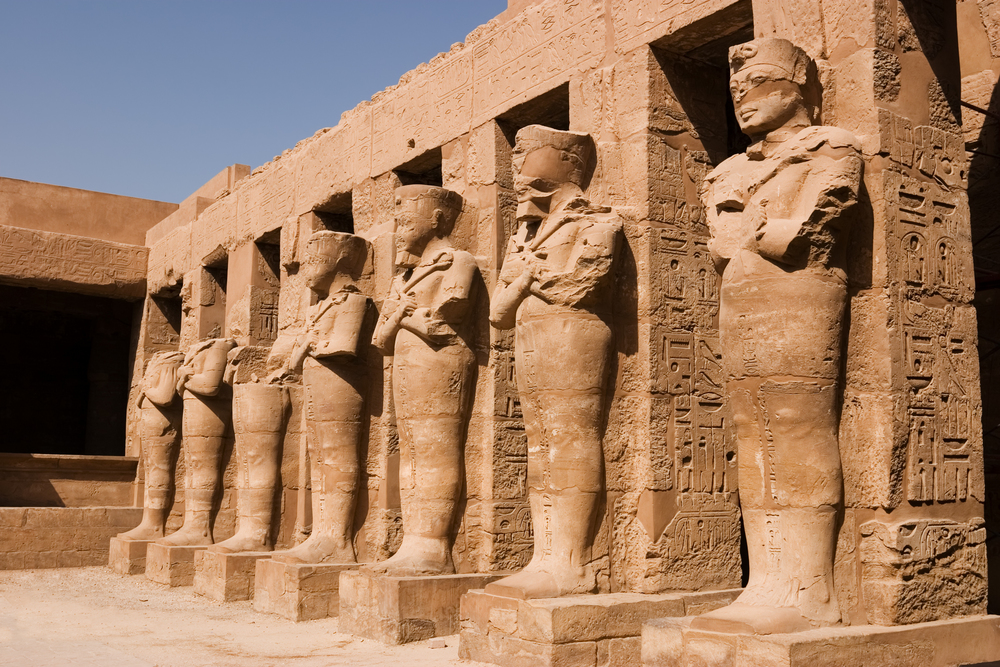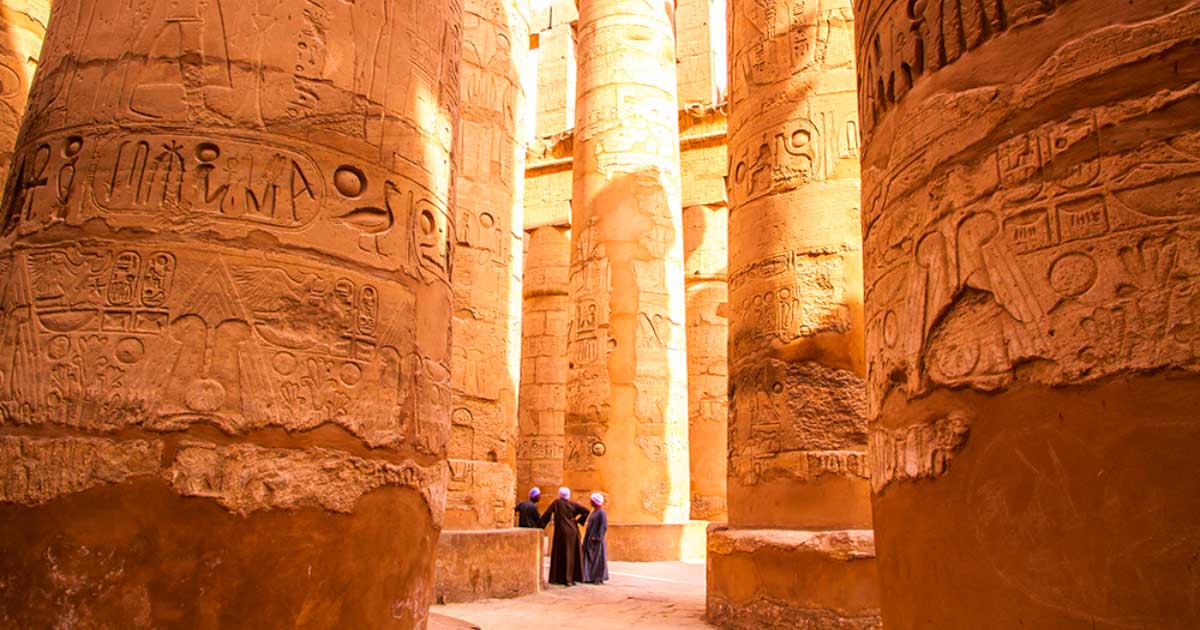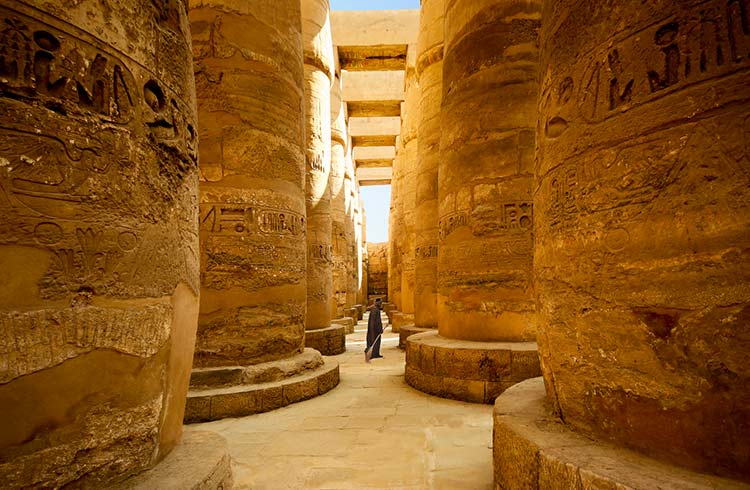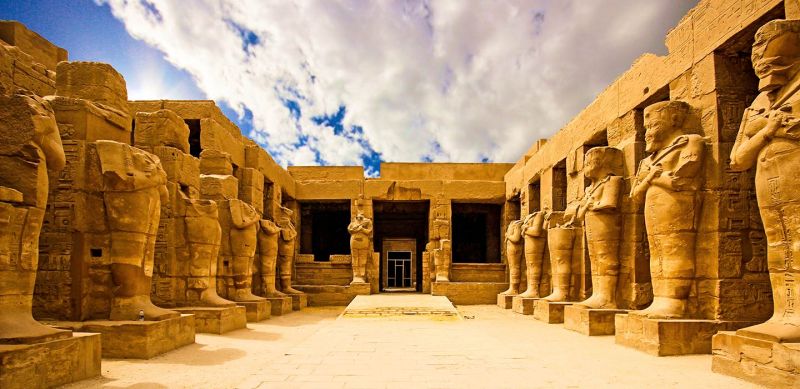The Secrets of Karnak Temple: Explore the Mysteries of This Ancient Egyptian Wonder

Introduction to Karnak Temple and its Significance in Ancient Egyptian History
Karnak Temple is one of the most impressive and significant ancient Egyptian temples, located on the east bank of the Nile River in Luxor, Egypt. Built and expanded over 2,000 years, from around 2055 BC to 30 BC, it served as a place of worship for the ancient Egyptian god Amun-Ra, along with his consort Mut and their son Khonsu. The temple complex covers an area of about 200 acres and features enormous pylons, obelisks, statues, and halls adorned with intricate reliefs and hieroglyphics.
Some key points about Karnak Temple and its significance include:
-
Religious Center: Karnak Temple was the religious centre of ancient Egypt and played a crucial role in the religious beliefs and rituals of the Egyptians. It was believed to be the dwelling place of the gods and the site of their divine presence on Earth.
-
Construction and Expansion: The construction of Karnak Temple began during the Middle Kingdom period and continued into the Ptolemaic period. Each pharaoh contributed to the temple, adding new buildings, sanctuaries, and decorations, resulting in the grandeur and complexity of the temple complex that we see today.
-
Hypostyle Hall: One of the most remarkable features of Karnak Temple is the Great Hypostyle Hall, which consists of 134 massive columns arranged in a grid pattern. These columns are intricately carved with scenes depicting various religious and historical events.
-
Avenue of Sphinxes: The temple was connected to the Luxor Temple by an Avenue of Sphinxes, a long processional avenue lined with sphinx statues. Today, only a part of this avenue remains, but it still offers a glimpse into the magnificence of the past.
-
Sacred Lake: Within the temple complex is a sacred lake that serves as a place for ritual purification and religious ceremonies.
Karnak Temple is a testament to the architectural and artistic achievements of the ancient Egyptians. Exploring its vast complex and learning about its history and mysteries can transport you back in time to the glory days of ancient Egypt.
To learn more about Karnak Temple, you can visit its dedicated page on Wikipedia.

Historical Background
Karnak Temple is a vast complex of temples located in the city of Luxor, Egypt. It was built and expanded over 2,000 years, starting in the Middle Kingdom and continuing through the Ptolemaic period. Here is some historical background on this impressive ancient wonder:
The history and mythology associated with Karnak Temple
- The construction of the Karnak Temple began during the 11th Dynasty of the Middle Kingdom. It continued throughout the New Kingdom, reaching its peak during the reign of Ramses II in the 13th century BCE.
- The temple complex was dedicated to worshipping the Egyptian deities, focusing mainly on the god Amun. Other important gods worshipped at Karnak included Mut, the wife of Amun, and their son Khonsu.
- Karnak Temple was not just a religious site but also a political and economic centre. It served as the administrative hub of the Ancient Egyptian civilization and a place for important religious ceremonies and festivals.
- The construction of the temple complex involved the work of numerous pharaohs and rulers over the centuries, leading to its immense size and grandeur. Each pharaoh left their mark on Karnak by adding new temples, statues, and decorative elements.
- The complex includes several main structures, such as the Great Temple of Amun, the Precinct of Mut, and the Temple of Khonsu. Pylons, courtyards, and shrines interconnect these structures.
- Karnak Temple was a place of pilgrimage for ancient Egyptians and attracted visitors from all over the country. It was believed that by visiting and making offerings at the temple, one could gain favour with the gods and receive blessings.
- Today, Karnak Temple is a popular tourist attraction and a UNESCO World Heritage Site. Visitors can explore the ruins of this majestic complex, marvel at the colossal statues and obelisks, and learn about the ancient Egyptian civilization and its religious practices.
You can visit this Wikipedia article to learn more about the fascinating history and mythology associated with Karnak Temple.

Architectural Marvels
At Karnak Temple, visitors can marvel at the impressive architecture and design showcasing the ancient Egyptians' incredible skill and ingenuity.
Exploring the impressive architecture and layout of Karnak Temple
Here are some key highlights of the architectural wonders you can expect to see at Karnak Temple:
Hypostyle Hall: One of the most famous features of Karnak Temple is the Hypostyle Hall, a massive hall consisting of 134 columns arranged in rows. The columns are intricately carved with hieroglyphs and reliefs, depicting scenes from ancient mythology and historical events. Walking through this hall is a truly awe-inspiring experience.
Avenue of Sphinxes: Stretching over 1.5 kilometres, the Avenue of Sphinxes connects Karnak Temple with Luxor Temple. The avenue had hundreds of sphinx statues, each representing a protective deity. Although many of the statues have been damaged or destroyed over time, the remaining sphinxes still glimpse the grandeur of ancient Egypt.
Obelisks: Karnak Temple is home to several obelisks erected as symbols of the pharaoh's power. The most famous obelisk at Karnak is the Luxor Obelisk, which now stands in the centre of the Place de la Concorde in Paris, France. Other smaller obelisks can still be seen within the temple complex.
Sacred Lake: The temple complex also includes a large sacred lake used for various religious ceremonies and rituals. The lake provided a water source for the priests and was believed to have purifying properties. The lake still holds a serene atmosphere today, offering a peaceful respite from the bustling temple grounds.
Temple Precincts: Karnak Temple is divided into several precincts, each dedicated to a different god or goddess. Each precinct features its pylons (massive gateways), courts, halls, and sanctuaries. Exploring each precinct allows you to immerse yourself in each deity's unique religious and cultural significance.
The architectural marvels of Karnak Temple are a testament to the incredible craftsmanship and engineering skills of the ancient Egyptians. A visit to this ancient wonder will leave you in awe of the grandeur and splendour of one of Egypt's most significant historical sites.
For more information about Karnak Temple, you can visit its Wikipedia page.

The Great Hypostyle Hall
One of the most awe-inspiring structures at Karnak Temple is the Great Hypostyle Hall, which is known for its grandeur and architectural marvel. Here's a closer look at this magnificent hall and its secrets:
Unveiling the secrets and grandeur of the Great Hypostyle Hall at Karnak Temple
-
The Great Hypostyle Hall is a monumental structure within the Karnak Temple complex in Luxor, Egypt. It was built during the reign of Pharaoh Seti I and completed by his son, Ramesses II, in the 13th century BC.
-
The hall covers an area of approximately 5,000 square meters and consists of 134 massive columns arranged in a grid pattern. These columns soar to up to 23 meters, creating a mesmerizing forest of stone pillars.
-
The hall was constructed to serve as a place of worship and was dedicated to the god Amun-Ra. It was used for religious ceremonies, including the annual Opet Festival, which celebrated the union of Amun-Ra with his divine wife, Mut, and their son, Khonsu.
-
The Great Hypostyle Hall is not only impressive in size but also in architectural design. The columns are adorned with intricate reliefs and hieroglyphic inscriptions depicting various religious scenes and offerings to the gods.
-
As you explore the Great Hypostyle Hall, you'll be immersed in the ambience of ancient Egypt. The sheer scale of the hall and the play of light and shadow create a sense of reverence and wonder.
-
Today, visitors can still experience the grandeur of the Great Hypostyle Hall and marvel at its architectural and artistic beauty. Walking among the towering columns, you can imagine the religious ceremonies and rituals that once took place within these hallowed walls.
To learn more about the Great Hypostyle Hall and Karnak Temple, visit Karnak Temple on Wikipedia.
The Great Hypostyle Hall is a testament to the ancient Egyptians' architectural genius and religious devotion. It continues to captivate visitors with its grandeur and mysteries, offering a fascinating glimpse into the rich history of Egypt's past.

The Sacred Lake
The Sacred Lake is one of the fascinating features of the Karnak Temple in ancient Egypt. Here, we uncover the significance and purpose of this mysterious body of water.
The significance and purpose of the Sacred Lake at Karnak Temple
The Sacred Lake, also known as the Great Sacred Lake or Mer-Wer (The Great Lake), was an integral part of the religious complex at Karnak Temple. Here are some key facts about this enigmatic feature:
-
Symbolic meaning: The Sacred Lake symbolized the primordial ocean, the source of life in ancient Egyptian mythology. It represented the concept of creation, regeneration, and rebirth.
-
Ritual purification: Priests and worshippers used the Sacred Lake to purify themselves before entering the temple. It was believed that bathing in the sacred waters would cleanse one's body and soul.
-
Offering rituals: The lake played a crucial role in the religious rituals and ceremonies held at the temple. Offerings, including food, jewellery, and statues, were made to the gods and goddesses by placing them in the water of the Sacred Lake. These offerings were believed to please the deities and ensure their blessings.
-
Symbol of fertility: The presence of the Sacred Lake at Karnak Temple symbolized fertility and abundance. It was associated with the Nile River, often called the "Great Green," which was the lifeblood of Egypt's agricultural prosperity.
-
Flora and fauna: The Sacred Lake was also home to various aquatic plants and animals, including lotus flowers and fish. These elements added to the natural beauty and tranquillity of the temple complex.
Visiting the Sacred Lake at Karnak Temple allows you to step back and witness the ancient Egyptians' deep spiritual connection with water, purification, and life cycle. It is a must-see attraction for anyone interested in Egypt's rich history and mythology.
To read more about the fascinating Karnak Temple, visit here.
Temples within Karnak
Exploring the various temples and shrines within the Karnak complex
Karnak Temple, located on the east bank of the Nile River in Luxor, Egypt, is one of the largest religious complexes in the world. It was a sacred place for ancient Egyptians, filled with architectural wonders and historical significance. Within the Karnak complex, there are several temples and shrines worth exploring:
The Great Hypostyle Hall: This hall is one of the most impressive features of the Karnak Temple. It consists of 134 massive columns arranged in a grid pattern. The columns are decorated with intricate carvings depicting scenes from ancient Egyptian mythology and history. Walking through this hall is a mesmerizing experience.
The Temple of Amun-Ra: Dedicated to the ancient Egyptian god Amun-Ra, this temple is the largest and most important within the Karnak complex. It served as a centre of worship and was believed to be the dwelling place of the god. The temple features grand entrances, towering obelisks, and beautifully preserved reliefs.
The Precinct of Mut: This temple complex is dedicated to the goddess Mut, the wife of Amun-Ra. It features imposing statues of lions and sphinxes and well-preserved reliefs depicting scenes from ancient Egyptian mythology. The Precinct of Mut provides insight into the importance of the goddess Mut in ancient Egyptian religion.
The Precinct of Montu: Montu was the ancient Egyptian god of war, and this temple complex is dedicated to him. It features a large court surrounded by walls adorned with reliefs depicting the deeds of Montu. The Precinct of Montu provides a glimpse into ancient Egyptian society's military and martial aspects.
The Temple of Khonsu: Dedicated to the moon god Khonsu, this temple is smaller than others in the Karnak complex. It features well-preserved reliefs, statues of the god, and scenes from ancient Egyptian mythology.
The Sacred Lake: Situated in the Karnak complex, the Sacred Lake was used for religious rituals and purification ceremonies. It is a serene and picturesque place, surrounded by columns and statues.
A visit to each of these temples and shrines is highly recommended to truly understand and appreciate the mysteries and wonders of the Karnak Temple. As you explore the complex, you will be transported back in time to the ancient world of the pharaohs.
Uncover more fascinating details about the Karnak Temple and its rich history on Wikipedia.

The Karnak Sound and Light Show
Immerse yourself in the enchanting world of ancient Egypt with the Karnak Sound and Light Show. This captivating experience takes place at the iconic Karnak Temple in Luxor, Egypt, and offers a unique way to explore the mysteries and history of this ancient wonder. Here's what you can expect from the Karnak Sound and Light Show:
A captivating experience of the Karnak Sound and Light Show
- The show begins as the sun sets over the temple, creating a magical ambience.
- Spectacular lights illuminate the temple's grand structures, showcasing their intricate details and architectural brilliance.
- As you walk through the temple grounds, you'll hear the powerful narration that tells the story of ancient Egypt, from the reign of Pharaohs to the construction of the Karnak Temple.
- The sound and light effects bring the temple's history to life, immersing you in the vibrant world of ancient Egyptian rituals and beliefs.
- The show highlights the significance of Karnak Temple in Egyptian mythology and its role as a centre of religious worship and political power.
- Majestic statues, towering pillars, and beautifully preserved hieroglyphs provide a backdrop to the mesmerizing audiovisual display.
- The experience is accompanied by a symphony of music and sound effects, creating a multi-sensory journey through time.
- The Karnak Sound and Light Show is a must-see attraction for history enthusiasts and travellers seeking a unique and immersive cultural experience.
To learn more about Karnak Temple and its fascinating history, visit its dedicated Wikipedia page.
Don't miss the opportunity to witness the magical Karnak Sound and Light Show, where history comes alive through a mesmerizing blend of lights, sounds, and storytelling.

Digging Deeper: Ongoing Archaeological Discoveries
Excavations and research at Karnak Temple continue to uncover new information about this ancient Egyptian wonder. Here are some insights into recent discoveries:
Insights into recent excavations and discoveries at Karnak Temple
- Ongoing excavations at Karnak Temple have revealed previously unknown chambers and structures, shedding light on the temple's layout and function.
- In 2020, archaeologists unearthed a massive statue believed to depict Amenhotep III, one of Egypt's most powerful pharaohs. The statue is over 10 feet tall and is incredibly well-preserved.
- Researchers have also uncovered numerous statues and artefacts dedicated to various Egyptian gods and goddesses, providing valuable insights into the religious practices of ancient Egyptians.
- Excavations have revealed evidence of rituals and offerings conducted by priests at Karnak Temple, further deepening our understanding of ancient Egyptian religious practices.
- Ongoing research at Karnak Temple aims to decipher the hieroglyphic inscriptions on the temple's walls, which contain valuable historical and religious information.
- The ongoing conservation efforts at Karnak Temple are crucial in preserving this ancient site for future generations and ensuring its cultural significance is not lost.
To learn more about Karnak Temple and its fascinating history, visit its Wikipedia page.
Preservation and Restoration Efforts
The preservation and restoration of the Karnak Temple complex have been crucial in ensuring that this ancient Egyptian wonder is protected for future generations. Here are some of the measures taken to preserve and restore this magnificent site:
Maintenance and Cleaning
- Regular cleaning and maintenance work is conducted to remove dirt, debris, and vegetation that may affect the integrity of the structures.
- Specialized cleaning techniques are used to gently remove dirt without causing damage to the ancient surfaces.
- Removing harmful deposits, such as black crusts, is carefully carried out to prevent further deterioration.
Structural Stabilization
- Extensive work has been done to stabilize the structures and prevent further collapse.
- Reinforcement techniques, such as installing steel beams and braces, support weakened areas.
- Advanced monitoring systems are in place to detect any signs of structural instability and allow for immediate intervention.
Conservation of Artworks
- Conservation experts work tirelessly to preserve the intricate artworks and reliefs throughout the temple complex.
- Delicate cleaning and restoration techniques revive faded colours and protect fragile surfaces.
- Advanced imaging technologies, such as digital mapping and laser scanning, are used to document and analyze artworks for better conservation strategies.
Site Management and Visitor Education
- Strict regulations and guidelines are implemented to manage visitor traffic and minimize the impact on the site.
- Information panels and guided tours provide visitors with educational insights into the history and significance of the Karnak Temple complex.
- Ongoing research and archaeological studies contribute to a better understanding of the site and facilitate informed conservation decisions.
These preservation and restoration efforts ensure that the Karnak Temple complex remains a remarkable testament to ancient Egyptian civilization and continues to inspire awe and wonder in visitors worldwide.
For more information about the Karnak Temple, you can visit this Wikipedia link
Visitors' Experience
Exploring the ancient wonders of Karnak Temple is a captivating experience that transports visitors back in time to the days of ancient Egypt. Here are some tips and suggestions to make the most of your visit to this incredible archaeological site:
Tips for Visiting Karnak Temple:
-
Plan your visit during the early morning or late afternoon to avoid the crowds and enjoy a more peaceful experience.
-
Wear comfortable shoes as you'll be doing a lot of walking and exploring.
-
Bring sunscreen, a hat, and a water bottle to stay hydrated under the hot Egyptian sun.
-
Consider hiring a guide to understand the historical and architectural significance of the temple fully.
-
Take your time to appreciate the intricate details of the hieroglyphics, statues, and obelisks that adorn the temple.
-
Don't miss the Sound and Light Show held in the evenings, which brings the temple's history to life through a stunning multimedia presentation.
Practical Information:
-
Location: Karnak Temple is located in Luxor, Egypt, on the east bank of the Nile River.
-
Opening hours: The temple is open daily from 6:00 AM to 5:30 PM.
-
Entrance fee: The entrance fee for Karnak Temple is 120 Egyptian pounds for adults and 60 Egyptian pounds for students.
-
Accessibility: The temple is wheelchair accessible, although some areas may have uneven surfaces.
-
Photography: Photography is allowed, but tripods and flash photography are usually prohibited.
To learn more about the fascinating history and significance of Karnak Temple, visit the Karnak Temple Wikipedia page.
Visiting Karnak Temple is a once-in-a-lifetime opportunity to witness the grandeur and beauty of ancient Egyptian civilization. Immerse yourself in the mystique of this incredible historical site and discover the secrets of the pharaohs.
